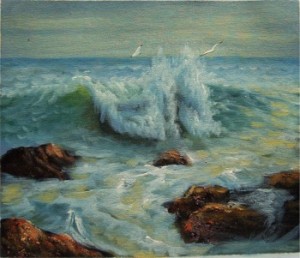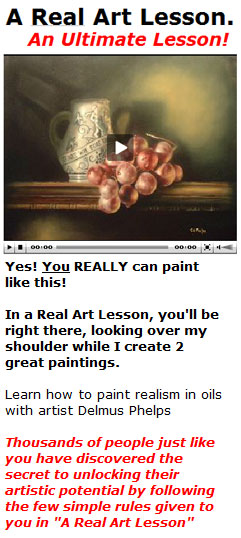Painting Ocean
Posted by admin | Under Oil Painting Saturday Apr 24, 2010 Standing on the stern of a small fishing boat 30 or 40 miles off shore, watching the fishermen going about their job of setting a trawl line, is a wonderful experience. What a gamble this life is!-2 miles of line with baited hooks 6 feet apart being dropped overboard, disappearing into the black ink of the ocean, taking a chance that the line will lie on the bottom in its proper position, wondering if the fish are there, always hoping that the winds and the ocean will remain calm so that the lines may be retrieved. Well into the night this work goes on. Strange that when these men are working at night few words are said. Each man with his own thoughts does his work with sureness and steady pace, to the rhythm of the ocean beneath the craft.
Standing on the stern of a small fishing boat 30 or 40 miles off shore, watching the fishermen going about their job of setting a trawl line, is a wonderful experience. What a gamble this life is!-2 miles of line with baited hooks 6 feet apart being dropped overboard, disappearing into the black ink of the ocean, taking a chance that the line will lie on the bottom in its proper position, wondering if the fish are there, always hoping that the winds and the ocean will remain calm so that the lines may be retrieved. Well into the night this work goes on. Strange that when these men are working at night few words are said. Each man with his own thoughts does his work with sureness and steady pace, to the rhythm of the ocean beneath the craft.
How fortunate to be an artist, and observe the seeds of incalculable numbers of paintings unfolding before your eyes. All men of deep emotion experience these feelings. The portrait painter looks into the depths of the faces of his sitters. The landscape painter wanders among his giants of the forest, shimmering lakes and tumbling rivers, feeling fresh-fallen snow crunch beneath his feet. The still-life painter observes the wonderful light that breathes life into his subject. Time passes so fast as one stands alone deep in thought!
Now dawn is upon our small craft and the men are talking with excitement, expecting soon to see the first fish hauled over the side. There is an excitement in the wind, too, for it has shifted to the southeast and has picked up to a steady breeze. The ocean is starting to get choppy. The fishermen are working hard and fast to get their catch in, and their gear aboard before they head for port. The wind is not going to let go; it is going to pound us harder, knocking the tops off the choppy oceans and sending a spray across our boat.
Three hours now of hauling gear. The ocean has lost its erratic chop and long deep swells are forming, driving our craft down the side of one wet mountain and up the other. The horizon is gone at times and one is looking straight out into a wall of deep water. We will have to abandon the remaining gear and make a run for home. Turning the boat’s stern to the oncoming ocean, we ride like a tiny surfboard being driven by an awesome force to the northwest.
“Here she comes!” someone calls out as a torrent of white foam breaks beneath our stern, then comes rushing into the small stern cockpit, driving gear and men against the bulkhead. This is no time for meditation-just hang on until we can reach the safety and calm of our harbor.
All through this experience I do not mention the sketch-pad, for the living of these moments are my sketches and I will relive this trip perhaps more vividly in my mind than a few sketches would ever recall to me. No matter what subject an artist chooses to paint, he should try to live his subject, not in two dimensions but in three dimensions, in great depth. Painting is a product of the mind, and the eyes are the lenses to it.
The entrance to the harbor is even more erratic than the open ocean. Into the small cove that forms the mouth of the port, the great oceans are shoaling up in sharp, twisting patterns, tossing the small craft as though it were so much driftwood. There is no rhythm to the ocean here. Through this we pass, to emerge into the quiet of another world. The stowing of the gear, the scrubbing down, the many things that go with securing a fishing vessel, are finished.
As I walk back to my studio with the swaying of the ocean still in my possession, I anticipate with excitement the large canvas that I have already half planned in my mind. A number of sketches will have to be made to work out a composition that will convey the feeling I experienced the moment that great ocean broke at the stern of our craft. First of an, it is the ocean I want to paint, not the boat, the open ocean with its great heaving masses I challenging all who dare her surface. The canvas I selected was 30 by 44 inches, so the perpendicular and diagonal lines of the painting will have a long sweep, and lend excitement to the up and down movement of the ocean. The horizontal lines will be held to a minimum. Even the ocean at the horizon will have this perpendicular action. The feeling must be that this storm continues for miles beyond the confines of this canvas. Three large basic shapes are all I will use for the movement of the ocean. If I use more, it will only tend to minimize the magnitude of the ocean around me. I must feel again as if I were in the valley of the deep, looking out into walls of water, and convey this feeling.
“The Following ocean” is typical of the pictures of a storm at ocean. Due to the lack of permanent rocks to help the foreground, I had to make use of large shapes of the ocean itself. The arrangement of the dark-and-light patterns had to take over for the depth in richness that rocks lend to paintings.
The colors for this picture consisted of Thalo blue, Thalo violet, Thalo green, yellow ochre, raw sienna, burnt sienna and Venetian red. The Thalo colors are dark and rich and give clarity and depth of color to the clean deep water of the open ocean. If you experiment on the palette with the above earth colors into the Thalo group, you will find that all of the clear, beautiful ocean colors can be realized with relative ease. I am assuming, of course, that your selection is based upon the color and tone of the sky, for after all, clear water is but a reflector.
I should like to stress that a painter of nature should never consider the start of any canvas without first paying strict attention to the Source of light and the sky itself. This canvas was washed in with very little color at the : outset, a blue-grey mixed with white to the proper values. The area of foam was laid in heavier and made a full tone lighter than the final effect called for. The foam pattern was held very simple and lighter, in anticipation of future glazing as the picture progressed. Care must be exercised while glazing with the above-mentioned colors, for they are strong and have great tinting power-if carried too far or if the picture is overpainted to excess, the glaze will make it hard and brittle in character. If you do experience difficulty with strong colors such as the Thalos, perhaps a more transparent group should be selected, such as viridian green, French ultramarine blue deep, ultramarine violet and ultramarine red. If glazing is a new departure for you, then start with a selection of colors that are by nature more transparent, and you will experience much less difficulty. Flake white is a good selection because of its quality of drying fast and because it is semi-transparent. Each succeeding day it will be sufficiently dry to proceed with the glazing.
